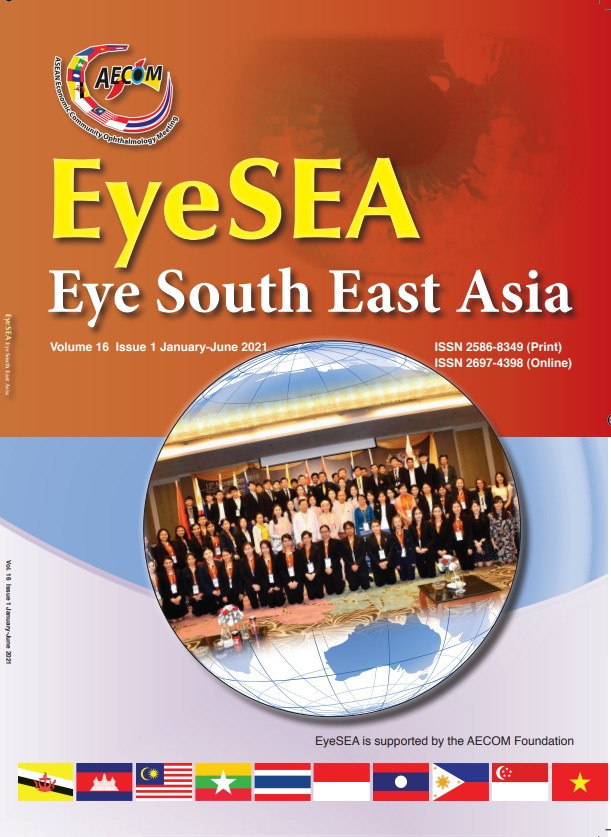Subconjunctival Bevacizumab injection on primary pterygium in Thammasat University Hospital: a randomized controlled trial
Main Article Content
Abstract
Purpose: To evaluate the reduction in horizontal dimension of primary pterygium after subconjunctival Bevacizumab injection.
Materials and methods: Subjects with primary pterygium were randomized to study group (subconjunctival Bevacizumab injection group) and control group. The inclusion criteria were adults (age older than 18) with primary pterygium less than 3 millimeters in horizontal dimension. The primary outcome is the reduction of horizontal dimension at 1 week, 1 month, 3 months and 6 months.
Results: Fifty-nine subjects with primary pterygium were enrolled in this study. The mean age is 56.25 years (± 12.90). Forty-seven subjects were female, the remaining were male. Mean size reduction in the Bevacizumab group was 0.517 mm. (±0.301), 0.710 mm. (±0.359), and 0.790 mm. (±0.361) at 1 month, 3 months and 6 months respectively. Mean size reduction in control group was -0.067 mm. (±0.258), -0.010 mm. (±0.304) and -0.003 mm. (±0.366) at 1 month, 3 months, and 6 months respectively. The p-value of difference in pterygium size reduction between Bevacizumab group and control group is less than 0.001 at all visit.
Conclusion: The reduction of horizontal dimension in primary pterygium at 1 month, 3 months and 6 months is significantly greater in those who received subconjunctival bevacizumab injection compared to the control group.
Article Details
References
2. Mak RK, Chan TC, Marcet MM, Choy BN, Shum JW, Shih KC, Wong IY, Ng AL. Use of anti-vascular endothelial growth factor in the management of pterygium. Acta Ophthalmol. 2017;95:20-7.
3. Mauro J, Foster CS. Pterygia: pathogenesis and the role of subconjunctival bevacizumab in treatment. Semin Ophthalmol. 2009;24:130-4.
4. Singh P, Sarkar L, Sethi HS, Gupta VS. A randomized controlled prospective study to assess the role of subconjunctival bevacizumab in primary pterygium surgery in Indian patients. Indian J Ophthalmol. 2015;63:779-84.
5. Fallah Tafti MR, Khosravifard K, Mohammadpour M, Hashemian MN, Kiarudi MY. Efficacy of intralesional bevacizumab injection in decreasing pterygium size. Cornea.2011;30:127-9.
6. Pasqualetti G, Danesi R, Del Tacca M, Bocci G. Vascular endothelial growth factor pharmacogenetics: a new perspective for anti-angiogenic therapy. Pharmacogenomics. 2007;8:49-66.
7. Bhisitkul RB. Vascular endothelial growth factor biology: clinical implications for ocular treatments. Br J Ophthalmol. 2006;90:1542-7.
8. Kasetsuwan N, Reinprayoon U, Satitpitakul V. Prevention of Recurrent Pterygium with Topical Bevacizumab 0.05% Eye Drops: A Randomized Controlled Trial. Elsevier HS Journals. 2015;37:10:2347-51.
9. Enkvetchakul O, Thanathanee O, Rangsin R, Lekhanont K, Suwan-apichon O. A randomized controlled trial of intralesional bevacizumab injection on primary pterygium: preliminary results. Cornea 2011;30:1213-8.
10. Razeghinejad MR, Hosseini H, Ahmadi F, Rahat F, Eghbal H. Preliminary results of subconjunctival bevacizumab in primary pterygium excision. Ophthalmic Res. 2010;43:134-8.
11. Shenasi A, Mousavi F, Shoa-Ahari S, Rahimi-Ardabili B, Fouladi RF. Subconjunctival bevacizumab immediately after excision of primary pterygium: the first clinical trial. Cornea. 2011;30:1219-22.
12. Besharati MR, Manaviat MR, Souzani A. Subconjunctival bevacizumab injection in treatment of pterygium. Acta Med Iran. 2011;49:179-83.
13. Mandalos A, Tsakpinis D, Karayannopoulou G, Tsinopoulos I, Karkavelas G, Chalvatzis N, Dimitrakos S.The effect of subconjunctival ranibizumab on primary pterygium: a pilot study.
Cornea. 2010;29:1373-9.
14. Mansour AM. Regression of Inflamed Pterygia by Frequent High-Dose Intralesional Ziv-Aflibercept. Cornea. 2017;36:1002-5.


